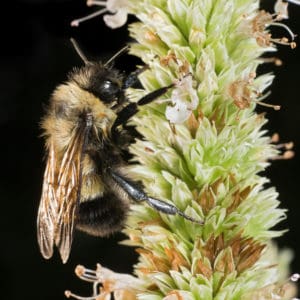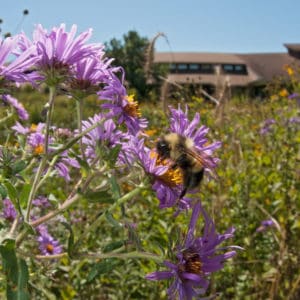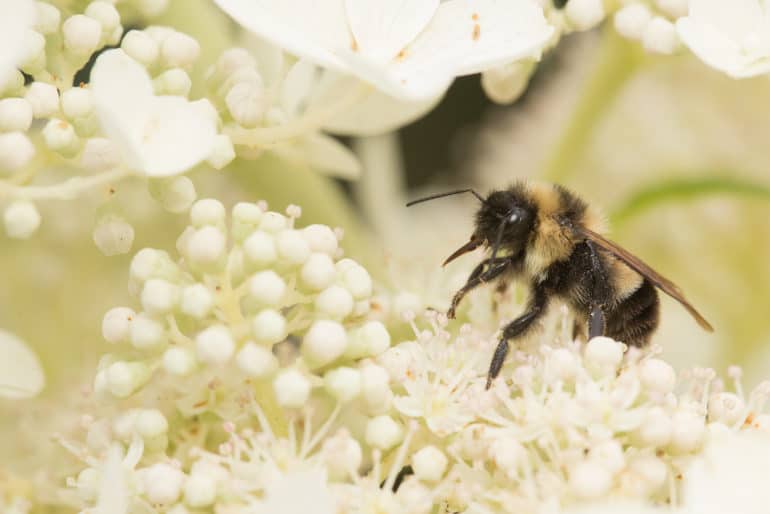The Rusty-Patched Bumble Bee was meant to become the first bee in North America listed under the Endangered Species Act (ESA), effective February 10, 2017. However, a regulatory freeze by President Trump’s administration has put a halt to the process and may reverse the decision. Fears that the ESA will be dismantled by the administration add to the uncertainty. Once considered an advancement in conservation while addressing a significant threat to a third of all crops, the decision is no longer an assured victory.
The original ruling by the United States Fish and Wildlife Service (USFWS) was based on considerable range reduction and threats to the remaining population from habitat loss and degradation, disease, pesticides, and small population dynamics. Since the late 1990s, the species’ population and range declined by 87 percent. Once common throughout the eastern U.S., it is now only found in a few pockets, mostly in Minnesota and Wisconsin. This species is an important pollinator, contributing to an estimated USD 3 billion annual economic boost from native insects. The USFWS study estimates a 90-percent probability of extinction for the Rusty-Patched in the next 30 years if no actions are taken.

The pressures the Rusty-Patched face are common to many pollinators including honey bees, which contribute an additional USD 15 billion in annual added crop value. The Environmental Protection Agency recently admitted that the most widely used insecticide in the world, neonicotinoids, kills bees, whereas the European Union has banned their use since 2013.
According to Dr. Reese Halter, biologist, environmentalist, and author of The Incomparable Honeybee & The Economics of Pollination, “America lost a record 44.1-percent of its honeybees last year, with chemical overloading of neonicotinoids (neonics) to blame for not only killing the bees but contaminating soil and the fresh water supply.” A recent study found that conventional pesticide additives also contribute to pollinator deaths. Introduced diseases, including fungi, are devastating bumble bee populations, with a 96-percent decline in some species over the last 20 years.
Conservationists and academics concerned with the future of the Rusty-Patched Bumble Bee banded together to create a movement to protect what remains of the species. An award-winning documentary, “A Ghost in the Making,” helped increase public awareness. Clay Bolt, Producer and Writer for the documentary, became involved after seeing stuffed passenger pigeons at Great Smoky Mountains National Park. “It was once the most numerous bird on the planet and then it was no more. I decided then that I had to do everything in my power to attempt to bring more attention to this beautiful little bee before it went the same way.”
A coalition was formed, led by the Xerces Society, that put pressure on the USFWS to assess the bees for possible Endangered Species listing. In their final ruling, the USFWS acknowledged campaigns by Xerces, Environment America, Environmental Action, Friends of the Earth, League of Conservation Voters, Sierra Club, and the Natural Resources Defense Council. Mr. Bolt commented, “I am just so encouraged and grateful for the public’s outcry in support of this species, which was integral in the USFWS’ decision. This was an effort that would have never been possible without so many people working together to see it through.”
Unfortunately, the coalition’s success is no longer guaranteed. Rich Hatfield, Senior Conservation Biologist at the Xerces Society, is motivated to get to work on “real conservation” and celebrated the ruling. However, he also acknowledges that, “a lot of this has been tempered by President Trump’s administration whose policies have at least delayed the finalization of the decision. Our hope is it is just that, a delay, but time will tell.”
Even if the government moves forward with listing the Rusty-Patched as endangered, many native pollinators face an uphill battle. Dr. T’ai Roulston, Curator of the State Arboretum of Virginia and Research Associate Professor in the Dept of Environmental Sciences at the University of Virginia, says “I think the listing of the Rusty-Patch as an endangered species is a great first step in recognizing the importance of insects in our ecosystems generally and our reliance on them in food production. This was a common bee 30 years ago and it disappeared from most of its range before we even noticed. Others are likely on a similar path.”

The fight is still on for the Rusty-Patched Bumble Bee and other pollinators. Dr. Roulston concludes, “What heartens me most is not that the Fish and Wildlife Service has listed it, which I applaud; no, it is that people cared enough to generate the information needed to list it and that so many people responded to the issue. There is suddenly a broad public interest in maintaining and improving pollinator habitat. Whether or not these actions save the Rusty-Patched Bumble Bee, they will certainly improve the habitat for many other species and ultimately ourselves.”
It is too early to tell what actions President Trump’s administration will take regarding the initial USFWS ruling. However, there are steps that individuals can take now. For resources on planting bumble bee-friendly gardens, click here. For staying up to date on pollinator news, follow the Xerces Society, the Sierra Club’s Pollinator Protection Campaign, or look up similar campaigns in most other conservation advocacy groups. Click here to watch the documentary, “A Ghost in the Making,” and learn more.
Special thanks to Clay Bolt for providing the pictures used in this article.















